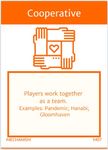Escaping the Laboratorium of Dr Moustache: Learning About Distanced Play Through Game Design
←
→
Page content transcription
If your browser does not render page correctly, please read the page content below
Escaping the Laboratorium
of Dr Moustache:
Learning About Distanced Play
Through Game Design
Melissa J. Rogerson, Lucy A. Sparrow, Sophie O. Freeman
School of Computing and Information Systems
The University of Melbourne
Level 5, 700 Swanston Street
Carlton Vic 3053
melissa.rogerson@unimelb.edu.au lucy.sparrow@unimelb.edu.au
sophie.freeman@unimelb.edu.au
Keywords
Boardgames, hybrid games, covid-19, distanced play
EXTENDED ABSTRACT
Tabletop gaming – where participants are traditionally co-located around a table –
was singled out during the COVID-19 pandemic as a particularly risky activity
(Benham 2020; Coward-Gibbs 2020). Players developed novel methods and creative
appropriations of household objects to play tabletop games together during this time
despite being physically distanced (Richards, Marcu, and Brewer 2021; Sparrow and
Rogerson 2022). Although several researchers have explored the novel design
opportunities that such distanced play presents (Yuan et al. 2021; Maurer and
Fuchsberger 2019; Rogerson, Sparrow, and Freeman 2022), few games have been
designed that specifically accommodate it. Notable exceptions are “distributed” Letter
Jam (Mills, Neustaedter, and Odom 2021), and the “Corona mode” of Soviet Kitchen
Unleashed (Wilde 2018).
Drawing on the reflexivity of design practice, we adopted Research through Design to
further understand the Distanced Play context, following the iterative process outlined
by Zimmerman and Forlizzi (2014) (Figure 1). Research through Design asks what
can be learned about a setting through the process of design, with a focus on
reflection and understanding rather than on the end products of the design: this
process can “‘make us alive to new aspects of’ a human domain of interest”
(Bardzell, Bardzell, and Hansen 2015, p. 2096).
Proceedings of DiGRA Australia 2023
© 2023 Authors & Digital Games Research Association DiGRA. Personal and educational classroom
use of this paper is allowed, commercial use requires specific permission from the author.Figure 1 How we followed the Research Through Design process
We conducted two sessions using the SMeFT Decks (Figure 2), which facilitate
ideation of games for hybrid distanced play through flexible prompts addressing a
game’s Story, Mechanisms, Functions, and Technology (Rogerson et al., 2022).
While our first session was exploratory, our second session focused on the interplay
between technologies and the functions that they afford (Rogerson, Sparrow, and
Gibbs 2021). We selected proximity sensors as an interesting technology and
remembering as the associated function. The story card and mechanism were selected
through a random deal.
Figure 2 The SMeFT Deck Prompts
Drawing from these card prompts, we designed Escape from the Laboratorium of Dr
Moustache. In this game, players are elemental princesses who are trapped, alone, in
an abandoned laboratory. They move around the game boards (Figure 3) attempting
to find one another, collecting resources that allow them to use special skills and
abandoned equipment, and to – ultimately – escape together. Speakers allow for voice
communication when players’ pieces are in proximity; sensors determine a princess’s
location on the board.
-- 2 --Figure 3 Sample board maps
While iterating our design, we extended our understanding of this complex design
space by focusing on questions related to implementation of the game. Our findings
and reflections address the use of technology to support a distanced play experience
and how technology connects to the timing and storytelling function domains.
Communication
Mills, Neustaedter, and Odom (2021) describe the importance of shared presence
during distanced play. We found that careful attention must be given to how
technology supports players’ communication during a game when they are not co-
located. Unlike Yuan et al. (2021), our focus here is on gameplay rather than on
incidental social interactions. We used sound to indicate when two Princesses were in
the same section of the laboratory (on the same board), and smart lights to show
where resources were located. Players in the same part of the laboratory are able to
communicate with one another through an audio feed from each player.
Board Design
Games with multiple boards can become prohibitively expensive if each board is
equipped with smart lights, location sensing and other technologies. In Dr Moustache,
each player has a single actuated board, with card overlays to represent the different
sections of the map. This efficient combination of simple overlays and electronic
components draws on the earliest-known digital boardgame Lichtra (1910) (Museum
für Energiegeschichte(n) 2007).
Timing
Both Maurer and Fuchsberger (2019) and Yuan et al. (2021) highlight the importance
of promoting a shared sense of time for distanced players. Dr Moustache senses
movement on the board and operates a count-down timer. The Princesses must escape
within a set time, before the laboratory is destroyed. This may be made more or less
explicit to players: a large countdown timer might be displayed, or this information
could be entirely hidden from players. Ambient options for communicating timing
include sounds (e.g. music, creaking of floors, ticking of a bomb) or lighting (e.g.
dimming the board’s lights as time progresses).
Connecting story and distance through technology
In Dr Moustache, the Princesses are distanced, just as the players themselves are.
Location sensors drive the game’s story. As players move closer to one another, they
are able to hear one another, but low light in the abandoned and unpowered
laboratory requires them to communicate by sound only. This connection between the
-- 3 --Princesses’ and the players’ distance supports the key activity of coming together in
an unexplored space.
We present Dr Moustache as both an artefact and an exercise in RtD, demonstrating
this method’s value for game design. Our future work will examine additional games
that address this design context and explore available technologies that can be used to
implement distanced play.
BIOS
Melissa Rogerson is a lecturer in human-computer interaction in the School of
Computing and Information Systems at The University of Melbourne. Her research
examines the play of boardgames in both physical and digital forms, as well as the
characteristics and motivations of hobbyist boardgame players, designers, and
developers. She is currently researching the application of digital tools in hybrid
digital boardgames and the potential for hybrid distanced play.
Lucy Sparrow is an Associate Lecturer in Human-Computer Interaction with the
School of Computing and Information Systems at The University of Melbourne. Her
interdisciplinary research lies at the intersection of ethics, digital technology, and
games, with a particular focus on the ethics of multiplayer gameplay and design. She
is also currently working on projects on hybrid digital boardgames, distanced play,
and the ethics of biometric capture in immersive performative environments.
Sophie Freeman is a PhD candidate in the School of Computing and Information
Systems at The University of Melbourne. Her research takes an interdisciplinary and
user-centric approach to investigate the design and effects of algorithmic features and
curation on music recommender systems.
ACKNOWLEDGMENTS
This work was supported by an Early Career Researcher Grant from The University
of Melbourne.
BIBLIOGRAPHY
Bardzell, Jeffrey, Shaowen Bardzell, and Lone Koefoed Hansen. 2015. "Immodest
Proposals: Research Through Design and Knowledge." Proceedings of the
33rd Annual ACM Conference on Human Factors in Computing Systems,
Seoul, Republic of Korea. https://doi.org/10.1145/2702123.2702400.
Benham, Danielle Adams. 2020. "What are the Effects of the Coronavirus on
Poker?". https://www.lasvegasadvisor.com/gambling-with-an-edge/what-are-
the-effects-of-the-coronavirus-on-poker-by-danielle-adams-benham/.
Coward-Gibbs, Matt. 2020. "Why Don’t We Play Pandemic? Analog Gaming
Communities in Lockdown." Leisure Sciences: 1-7.
https://doi.org/https://doi.org/10.1080/01490400.2020.1773986.
Lichtra. 1910. Berlin-Neukölln, Germany: FPR.
Maurer, Bernhard, and Verena Fuchsberger. 2019. "Dislocated Boardgames: Design
Potentials for Remote Tangible Play." Multimodal Technologies and
Interaction 3 (4): 72. https://doi.org/10.3390/mti3040072.
Mills, Chelsea, Carman Neustaedter, and William Odom. 2021. "Distributed Letter
Jam: Designing Distributed Board Game Play for Social Connection."
Companion Publication of the 2021 Conference on Computer Supported
Cooperative Work and Social Computing.
Museum für Energiegeschichte(n). 2007. Energiegeschichten. Hannover: Museum für
Energiegeschichte(n).
-- 4 --Richards, Olivia K., Gabriela Marcu, and Robin N. Brewer. 2021. "Hugs, Bible
Study, and Speakeasies: Designing for Older Adults’ Multimodal
Connectedness." Designing Interactive Systems Conference 2021, Virtual
Event, USA. https://doi.org/10.1145/3461778.3462075.
Rogerson, Melissa J., Lucy A. Sparrow, and Sophie O. Freeman. 2022. "The SMeFT
Decks: A Card-Based Ideation Tool for Designing Hybrid Digital
Boardgames for Distanced Play." Proceedings of the Australian Conference
on Computer-Human Interaction (OzCHI22), Canberra, Australia.
Rogerson, Melissa J., Lucy A. Sparrow, and Martin R. Gibbs. 2021. "Unpacking
“Boardgames with Apps”: The Hybrid Digital Boardgame Model."
Proceedings of the 2021 CHI Conference on Human Factors in Computing
Systems.
Sparrow, Lucy A., and Melissa J. Rogerson. 2022. "Shoeboxes, chandeliers, and
screenshares: How players appropriated material and digital technologies for
distanced boardgame play during the COVID-19 pandemic." ANZCA 2022,
Communicating through Chaos: Connection, Disruption, Community, The
University of Wollongong, Australia, Nov 22-25, 2022.
Wilde, Andreas. 2018. Soviet Kitchen Unleashed. Dresden, Germany: HYBR.
Yuan, Ye, Jan Cao, Ruotong Wang, and Svetlana Yarosh. 2021. "Tabletop Games in
the Age of Remote Collaboration: Design Opportunities for a Socially
Connected Game Experience." Proceedings of the 2021 CHI Conference on
Human Factors in Computing Systems, Yokohama, Japan.
Zimmerman, John, and Jodi Forlizzi. 2014. "Research through Design in HCI." In
Ways of Knowing in HCI, edited by Judith S. Olson and Wendy A. Kellogg,
167-190. New York: Springer.
-- 5 --You can also read
























































